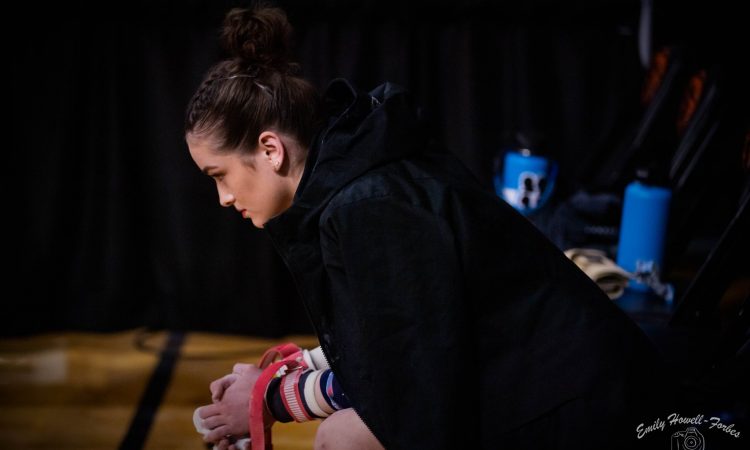With so much uncertainty surrounding pretty much everything having to do with everything, all there is to do these days is speculate and think of the many questions we have about how, when and things will return to normal.
When it comes to NCAA gym, there are more questions than not these days, and we hope to get at least a few answers in the coming months as more information becomes available and new rules and regulations are decided.
Timing
We’ve seen some club gyms going to back to practice in states that are easing distancing guidelines, but so far college programs don’t seem anywhere near ready to make that call. When will gymnasts be able to start training? How long after that date is it practical to be able to expect them to compete? If teams only start training again around, say, Thanksgiving, it doesn’t seem likely we’ll see meets in January, or even later. Remember, traditionally preseason is about a full semester long.
There are many avenues the NCAA might take. Will we have an abbreviated season? Would the season be moved to either start and or finish later in the year? Both seem possible. Of course, there’s always the chance that we’ll have a second or third wave of the virus, in which case we have to ask the hardest question: Will the season be cancelled altogether?
If the NCAA (or WCGA, whoever ends up making those big choices) goes for that most drastic option, there is a possibility that avoids simply missing the 2021 season altogether. Would gymnasts get the same treatment as football and have its season “moved” if it can’t happen as scheduled?
All of these questions and how they are resolved will affect recruiting, too. Will we see some expected 2021 non-elite freshmen defer to guarantee a “normal” four-year college experience? Our gut-instinct, wild guess is yes.
Schedules
Our favorite gossip king on the gymternet, Greg Marsden hinted that teams are actively trying to tweak their schedules to get rid of “unnecessary” out of conference meets to limit travel costs. What sort of changes might we see to the typical NCAA gym schedules we’ve become accustomed to? More quad meets? More double meet weekends? Quad meets would certainly save money but wouldn’t necessarily solve any problems with the amount of scores a team gets, just with the amount of opponents it would face. Maybe we see more teams pull an Alaska and compete away at the same school twice in a weekend or visit multiple teams in the same area in one trip.
What happens if some teams have a season and others don’t? This could be on a country-wide or conference basis. What “level” of team would it take to force change across the board? All of the MAC not participating? UCLA? Oklahoma?
Some teams—Alaska, William & Mary—already have just over the bare minimum of meets for NQS. How will it be calculated if there is a shortened season? Count all meets and drop high and low? Keep NQS the same and make teams have to deal with less opportunities to drop bad meets? Change NQS to top four scores with at least two away?
It’s become trendy lately to award a regular season championship to teams as well as one after the conference meet. These are typically based on win-loss record rather than scores or NQS. How will conference records be calculated if not all teams in a conference hold a season? While it’s less likely only some teams in a conference compete instead of the conference making a decision for everyone, we can’t rule anything out at this point. If the SEC says no conference championship, what’s stopping LSU from hosting five exhibitions anyway?
Postseason
The MAC already eliminated or altered the postseason for some sports. Will gymnastics get hit as well?
It’s rumored some teams are already taking measures to cut costs when it comes to out of conference meets or other unnecessary travel. Will it be safe for teams to travel what could be farther distances for regionals or nationals? Plus, meets with four teams on the floor can get pretty crowded. What measures will be put into place to enforce physical distancing? Will postseason quads turn into duals? Will new hosts with bigger arenas and thus more room to spread out be selected?
The NCAA has said it won’t make sweeping decisions about all teams or sports but will it cancel the championships it’s in charge of? We saw with the 2020 season the NCAA cancel all spring and summer championships, leaving remaining regular season competitions to be somewhat pointless. Will we see the NCAA hold off on making decisions again like it did in the spring, only resorting to canceling the events its in charge of?
Budgets
The NCAA allows teams to have three paid coaches on staff for gymnastics. Will we see more teams running with fewer than that to help save money? Universities are also furloughing or cutting the budgets of its athletics staff and coaches, even at big universities like Georgia. While this might not be that significant for a coach that makes 200K a year, most of the NCAA gym teams in the country survive on much less.
We’re here to discuss the important issues. Which leads us to… Will teams not introduce new leotards? It would be easy to argue that many teams have at least one or two, if not more, leos leftover from the 2020 season that no one has seen yet. With leotards being so expensive, it could be an easy way to save money as teams typically wear a new leo every single weekend. Bright side? Maybe we’d get to see some throwback classics that teams have in their closets but haven’t worn the past few seasons.
Will we see a reduction in the number of scholarships some bubble DI teams carry? Despite being a DI team, in its final year UIC was not operating with a full 12 scholarships, which is what allowed it to compete at USAG nationals and finish second. There’s a good chance more teams have to cut down on scholarships to stay afloat with the bright side being more teams eligible for the USAG postseason.
Akron, a MAC school has already eliminated three teams, including some that don’t appear to be that expensive to run, plus Bowling Green has gotten rid of baseball. Will any gymnastics teams follow?
Will some walk-on athletes simply not be able to afford to return to school? A lot of times walk-ons are in-state athletes, but some head out of state to expensive universities to compete for their dream school. However, times are tough financially for a lot of people right now, meaning some non-scholarship athletes might not be able to continue school for another year. Similarly, it costs a team money for each additional student athlete it has. That’s one more leotard, one more set of apparel, one more airplane ticket or hotel room. Will we see some teams that typically have a healthy number of walks-ons cut down on the extra individuals on its team?
Eligibility
There’s talk about shortening the 2021 season if it does still occur. If the season is abbreviated, how will that impact eligibility? We’ve already seen the NCAA deny extra eligibility for winter sports that had their 2020 seasons cut short. Would it see this as a similar case or work out another way to allow 2021 competitors extra competition time.
If the season is cancelled, will all athletes be afforded an extra year of eligibility? This one is a little easier to guess since the NCAA did grant extra eligibility to spring sport athletes in 2020. But what happens when we know about issues far in advance?
Will decisions around eligibility impact the special dispensations gymnasts attempting to qualify to Tokyo are using to defer? At this rate, Jade Carey, for example, will enter college as a freshman when her original classmates are seniors. She’ll surely have to receive special permission if she wants all four years of eligibility, even with the special exceptions the NCAA makes for athletes training for the Olympics. Will Carey even still join Oregon State after all this time? What will the NCAA decide, likely on a case-by-case basis, about those individuals that are now deferring once again for “2020ne,” which includes MyKayla Skinner and Morgan Hurd among others?
Our Biggest Concerns
Obviously, the No. 1 most important thing is the health and well-being of everyone involved, including athletes, coaches, judges, media and fans. But these are some concerns Editor in Chief Elizabeth, Managing Editor Emily M and Senior Editor Rebecca have beyond the obvious.
Emily M: I’m worried about our mid- and lower-tier DI programs. The current situation might give ADs a chance to say, “alright, it’s time for gym to go.” MAC is especially concerning, given that non-gym MAC school Akron has already dropped programs, Bowling Green dropped baseball and the conference is concerned enough about budget to limit postseason play, even in sports like men’s basketball. That’s a huge red flag. I’m also worried about our MIC programs, which are already competing outside a “traditional sport” conference.
Elizabeth: I’m worried teams in states that have less strict precautions in place will compete as planned while other teams will be stuck at home. We already know Los Angeles mayor Eric Garcetti said the stay at home order would likely extend through August. What if that continues on and on and eventually a school like UCLA cancels in-person instruction for the spring? Would we have a situation where LSU is competing and UCLA is stuck at home? Will we have a situation where this season just be a long list of what ifs and asterisks?





My question is, Is it a fair playing field when you have some teams practicing and other teams like in California that can’t hold practice or even meet up as a team due to the state guidelines Like Sacramento for instance. They can’t practice and may not be able to until Nov. It is really putting a toll mentally on some teams. They are stressing about being ready or if they will even have a season due to budget cut and not being able to practice.